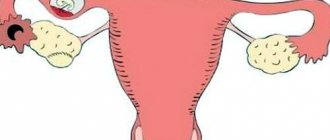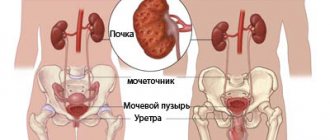Why is my stomach churning?
The sensation can be compared to a weight suspended inside, which causes pain and downward pressure. The reason is the contraction of the uterus, which is based on a dense muscle corset. The sensations spread to the neck, which gives a downward pulling effect.
It can hurt like this before menstruation and in the first days, when contractions help the endometrium to be rejected and come out. It can be caused by an enlargement of the uterus during pregnancy, as well as during contractions at the time of childbirth. In these processes, sensations are caused by hormones that cause the myometrial muscles to contract at the right time.
An imbalance in the endocrine system leads to cramps that are not associated with menstruation or other natural processes. In addition, contractions occur due to inflammation. Due to tissue swelling and increased blood supply.
Attention! According to women, often smearing with brown and pulling on the bottom resulted in a positive pregnancy test after a few days.
Discharge after sex
Normally, after intimate relations, the discharge should be mucous, without any foreign odor. Blood after sex, a feeling of discomfort and pain should be a reason to contact a gynecologist, especially if they appear repeatedly. Unpleasant symptoms can be physiological in nature (if it is the beginning of menstruation, first sexual intercourse, insufficient vaginal moisture), and in this case the woman’s condition can be easily corrected in accordance with the doctor’s recommendations.
In emergency cases, urgent hospitalization is necessary, but more often you can visit a doctor as planned, after which the specialist will prescribe treatment based on the identified pathology.
However, the reason may also be the development of gynecological pathology (inflammation, cancerous tumors, benign neoplasms, cervical erosion), which needs to be diagnosed (examination by a doctor, pelvic ultrasound, smears for flora and oncocytology) and timely treatment.
It is important to pay attention not only to the presence of blood during intimate contact, but also to other warning signs, so that you know what to do if there is blood during sex - relax or urgently consult a doctor for consultation and treatment. To clarify the reasons, the woman is prescribed several types of examination:
- examination on a gynecological chair;
- colposcopy to determine the condition of the cervix;
- performing an analysis of vaginal smears to exclude sexually transmitted diseases;
- pipel biopsy;
- Ultrasound to determine the condition of the endometrium;
- hysteroscopy (for regularly recurring bleeding).
If you suspect a precancerous condition of the tissues of the cervix, endometrium, or external genitalia, consultation with an oncologist is required.
Why does brownish discharge occur?
Dark-colored smear is cervical mucus with caked blood, in some cases it also contains endometrium. More often it is explained by hormonal diseases and spasms of the uterus, as a result of which the intrauterine layer is rejected, almost like during menstruation.
Severe inflammation also causes bleeding due to tissue damage. In addition, the process is accompanied by increased blood supply at the site of localization. Such discharge is not periodic, as with hormonal disorders. And the pain during infections is rather aching, sometimes pulling the lower back.
Green vaginal discharge is a bacterial infection
Vaginal discharge with a characteristic greenish color often indicates a bacterial infection (vaginosis), which can be caused, for example, by pathogenic microorganisms of the species Gardnerella vaginalis.
Gardnerellosis is most often accompanied by burning and itching of the perineum, swelling of the labia, pain when urinating, as well as a characteristic fishy odor from the vagina. If these symptoms appear, consult a gynecologist, as ignoring them can lead to serious health problems - bacteria can enter the cervical canal.
Burning and itching of the perineum
Green vaginal discharge may also indicate atrophic vaginosis, which affects women during menopause and when estrogen levels in the blood are low.
When is it normal to notice brown spotting and stomach pain?
Physiological processes are also accompanied by similar signs. The intensity of the manifestations depends on the individual characteristics of the woman’s body.
Menstruation
Brown discharge before menstruation, coupled with abdominal pain of a pulling or cramping nature, may be a sign of the onset of menstruation. If this always happens, then this is a variant of the norm, when a complex of manifestations appeared suddenly, then the development of endometriosis, endometritis, hormonal imbalance or uterine polyp is possible.
Brown discharge instead of menstruation with cramps on one side of the abdomen may indicate a lack of progesterone, polycystic ovary syndrome or a cyst.
Ovulation
Normally, the release of the finished egg is accompanied by clear, abundant and viscous mucus. However, when the follicle ruptures, blood appears, which, under favorable circumstances, reaches the cervical canal and mixes with the secretion. Then pink or brown discharge in the middle of the cycle will be a sign of ovulation. Not all women experience nagging pain in the abdomen during this period; they are explained by contraction of the tubes, which thus draw the egg into the uterine cavity.
Carefully! In the middle of the cycle, blood with cramps often occurs due to endometriosis or hormonal disorders.
Implantation of fertilized egg
A week or more after conception, the embryo reaches a stage of development where it can attach to the wall of the uterus. It literally takes root in the loose endometrial layer, which is thus injured. Implantation bleeding in volume, like ovulation bleeding, is only a few drops. Vaginal mucus turns pale and pinkish or brownish discharge appears a week before menstruation, on the eve or already when there is a delay, depending on the length of the cycle and the date of ovulation. Immediately after this, hormones begin preparing for the process of bearing a child, the uterus fills with blood and gradually enlarges, so there is a pulling sensation in the lower abdomen. If they are intense and painful, then miscarriage is possible due to embryo rejection.
When to worry: signs of illness
Mid-cycle spotting, the causes of which are not related to normal physiological secretions, may be a sign of a gynecological disease. You should pay special attention to your health if leucorrhoea is accompanied by the following symptoms:
- unpleasant odor or heavy discharge;
- pain or cramping in the lower abdomen (moderate to severe);
- itching and burning;
- painful sexual intercourse;
- general intoxication (fever, weakness);
- long period of discharge (from several days);
- the appearance of blood clots;
- regular discharge (appears over several cycles).
Many serious gynecological diseases (cancer, polyps, fibroids, etc.) can be asymptomatic in the early stages, so delay in diagnosis and treatment is deadly
What besides pathologies can cause abdominal pain and brown spotting?
As a rule, these are hormonal changes of a temporary nature or injuries that arise due to various circumstances:
- Taking oral contraceptives, which basically contain estrogen and progesterone. Their action is based on changes in physiological processes. Therefore, uterine spasms and endometrial detachment normally occur during the intermenstrual period in the first 3 cycles, and sometimes up to six months. The sensations are moderate, and the discharge is dark, sometimes with clots, but not abundant.
- Abdominal injuries as a result of an accident, blow or fall can provoke detachment of a large fragment of the endometrium, as well as myometrial spasm as a result of a reaction to the injury. It is noted that a large mass comes out once and is smeared for several more hours. If the symptoms do not disappear after a day, or the bleeding increases, you should consult a doctor.
- Sports, jumping, strength training, intense sexual intercourse can provoke in the second phase of the cycle of myometrial contraction and spotting brownish discharge before menstruation.
- An intrauterine device is a foreign object that the uterus tries to push out through contractions. The darkish daub is a damaged endometrium.
- After operations, abortions, and curettages, direct trauma occurs to the surface of the organ, as well as the cervical canal. Therefore, within a few days, the uterus contracts as a result of the intervention and the remaining blood from the damage comes out. The woman feels cramping and stretching in the abdomen, as well as spotting brown discharge with clots.
- Stressful situations affect the balance of sex hormones. The reaction to shock varies, often with minor uterine bleeding and discomfort in the abdomen.
Interesting fact! Diets with a monotonous set of foods can lead to brown spotting instead of menstruation. This condition ends in a complete absence of menstruation and infertility.
Brown vaginal discharge - what to be afraid of?
Not all brown vaginal discharge is cause for concern. Very often, this type of spot appears just before the start of menstruation. Vaginal discharge can also occur during ovulation or during the first stage of pregnancy when the embryo implants into the uterine lining.
However, sometimes brown vaginal discharge can be a sign of health problems if it is a symptom of bacterial vaginosis or pelvic inflammatory disease.
Brown spots may appear after taking birth control pills. In general, this is not a cause for concern - the body reacts to hormones in this way. However, if the problem persists for more than 2-3 days, you should seek help from a doctor, who will determine whether the vaginal discharge is a symptom of a more serious condition.
Self-medication for any type of discharge is prohibited, as you can do more harm to the body than good.
ONLINE REGISTRATION at the DIANA clinic
You can sign up by calling the toll-free phone number 8-800-707-15-60 or filling out the contact form. In this case, we will contact you ourselves.
Signs of pathology
If your stomach is tight and there is a bloody smear, then you need to pay attention to the following symptoms:
- Body temperature is elevated and remains around 37-38°;
- Itching in the genital area;
- The pain is intense, cramping or cutting, and also, if localized on one side;
- The discharge smells like fish, rotten eggs, or rotten meat;
- Pain appears periodically on certain days of the cycle (DC);
- Leucorrhoea copious and dark;
- The spotting turns into bleeding;
- There are pieces and lumps in the mucus.
Symptoms appear at specific times
If the manifestations depend on the DC and occur regularly or once in a special period, then the range of assumptions can be narrowed.
| Cycle period | Once | Regularly |
| Instead of menstruation | Hormonal imbalance, pregnancy | Ovarian pathology, polycystic or cyst, or tumor |
| After menstruation | Release of endometrial remains | Endometriosis |
| Ovulation | Ovulation bleeding | Endometriosis, fibroids, hyperplasia, taking hormonal drugs |
| Second phase | Embryo implantation, trauma, stress | Endometriosis, hormonal disorders |
Regardless of the situation, the DC pulls in the lower abdomen, and brownish discharge occurs due to ectopic pregnancy, cancer tumors, polyps, and erosion.
Diseases of the reproductive system with abdominal pain and brown spotting
This symptom complex manifests itself in almost all gynecological disorders. Even a professional without laboratory and instrumental diagnostics is sometimes unable to distinguish them from each other.
Polyps
Tentacle-like growths from 5 to 50-60 mm appear in the uterus or cervical canal. When injured, they bleed, and at other times they produce mucus. They are characterized by long and heavy periods, as well as brown spotting or mucous discharge streaked with blood, contact bleeding after intimacy. When detected, polyps must be removed to avoid malignancy.
Erosion
Atypical change in the covering layer of the cervix. It does not manifest itself in any way except for bleeding from the slightest impact. A slight red-brown smear without clots or veins immediately after sex.
Endometriosis
Copious intermittent dark brown discharge during ovulation. Spotting at the beginning and end of menstruation, cramping pain in the lower abdomen. All this happens with a severe hormonal disorder, which causes the spread and growth of the endometrium in the uterus and beyond.
Hormonal disorders are not only diseases of internal organs, but also negative changes in appearance. Hair loss on the head and its growth throughout the body, acne, oily skin, loss of feminine contours of the figure are a consequence of a lack of necessary hormones. The reason often lies in the woman's lifestyle.
Endometritis
An infectious process in the uterus that develops in the thickness of the uterine mucosa. Occurs when an STI spreads from the vagina. Opportunistic microorganisms can also cause the disease. The woman's temperature rises, pulling and cutting pains in the lower abdomen, brown spotting with an unpleasant odor occur. It is treated with long-term systemic antibiotics, which are selected individually for each infection.
Adnexit
Bacterial infection of the tube and ovary on one or both sides. Liquid, water-like discharge with a green tint and a foul odor appears regularly. Sometimes a brownish smudge occurs, as well as an increase in temperature and nagging pain on one side and in the lower back. Eliminate the process with antibiotics.
Myoma
A benign tumor forms in the muscle layer of the uterus under the influence of hormonal disorders. Provokes a scanty brownish smear in the intermenstrual period. Menstruation is long with heavy discharge. The lower back hurts and pulls in the lower back, as well as as a result of sex. They are treated comprehensively, combining hormonal restoration with minimally invasive surgical methods; in severe cases, they resort to removing the uterus affected by large myomatous nodes.
Infections
Colpitis caused by candida, gardnerella or STD pathogens in severe cases causes ulceration of the mucous membrane of the vagina and cervix. Green, yellow, white cheesy discharge appears regularly, accompanied by severe itching of the perineum and an unpleasant odor. They are sometimes accompanied by bloody inclusions. The result is muddy tones. Sometimes sanitation with vaginal suppositories with an antibiotic is sufficient for treatment. For STIs, systemic antibacterial drugs are used.
Cysts
Fluid-filled formations on the ovaries lead to hormonal disorders with endometrial detachment, and also injure the gland tissue. Therefore, spotting and sharp and nagging pain occur on one side. Cysts can only be removed through surgery, which is performed either laparoscopically or openly.
Scary facts! Ovarian cysts can reach very large sizes. American doctors removed a tumor weighing 33 kg and 1.5 m in girth from a woman from Mexico.
Oncology
Cancerous tumors at the initial stage provoke endometrial rejection and bleeding, and in advanced cases they appear as dark discharge with debris of dead tissue. In addition, there is copious watery discharge. Severe damage ends with necrosis, which is characterized by the aroma of rotting meat. Treatment consists of excision of the uterus or complete supravaginal amputation of the reproductive organs.
White vaginal discharge - what does this mean?
White vaginal discharge is completely normal. The problem arises when they acquire a dense consistency that begins to resemble cottage cheese, and numerous lumps appear in them. Such symptoms may indicate an infection of the yeast (fungus) Candida albicans, which colonizes the vagina, perineal area, labia and anus, also causing additional problems.
The most common symptoms of thrush include persistent itching and burning in the intimate area and vagina, redness and swelling of the labia, and a feeling of dryness in the vagina. Usually the white discharge from a yeast infection does not have a bad odor, but sometimes you may notice a yeast-like odor.
White vaginal discharge
How to treat white vaginal discharge? First of all, it is recommended to consult a gynecologist who will prescribe suppositories or ointments with antifungal substances. Most often, the use of both forms of medication is required - suppositories heal the infection in the vagina and restore normal microflora of the genital tract, while ointments applied to the labia and anal area minimize unpleasant symptoms - itching and burning.
Pulling and smearing brown during pregnancy
Such a symptom complex is always dangerous when carrying a child. In the early stages there is a risk of miscarriage, in the second and third trimester there is a risk of premature birth, abruption or placenta previa. Therefore, brown discharge during pregnancy in combination with nagging pain in the abdomen is a reason to call the emergency room, and before its arrival the woman needs to lie down.
In addition, these signs occur in the presence of polyps or erosion. Then the daub is often of a contact nature. Constant bleeding is dangerous for the expectant mother, so the formation can be eliminated from 16 to 27 weeks.
Ectopic pregnancy
If 10-14 days after conception your stomach begins to ache, the pain intensifies every day, and at this time spotting turns into bleeding, then you should check for an ultrasound. Sometimes the embryo is implanted in the epididymis, near the ovary, or even in the abdominal cavity. The growth of the embryo in the tube leads to its stretching and subsequent rupture. If such a moment comes, the woman falls into a critical state with loss of consciousness, vomiting and unbearable pain. Blood can also go into the abdominal cavity, then diagnosing the problem is more difficult. Emergency surgery is required.
Discharge associated with pregnancy
Brownish leucorrhoea in the middle of the cycle may indicate the beginning or end of pregnancy (miscarriage). Why is this happening?
When a fertilized egg attaches to the uterus, the endometrial vessels may be slightly damaged. The released blood stains the mucus. Sometimes mild spasms may occur.
Heavy discharge, which is accompanied by severe pain, nausea and cycle disruption, can be a symptom of an ectopic pregnancy.
If the fertilized egg detaches from the endometrium (due to the non-viability of the fetus or the presence of scars and adhesions in the uterus), a miscarriage occurs, which is accompanied by slight bleeding (duration - up to 48-72 hours).










